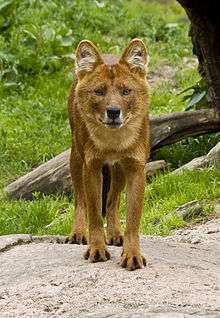Ussuri dhole
| Ussuri dhole | |
|---|---|
 | |
| A captive Ussuri dhole at Kolmårdens djurpark, Sweden. | |
| Scientific classification | |
| Kingdom: | Animalia |
| Phylum: | Chordata |
| Class: | Mammalia |
| Order: | Carnivora |
| Suborder: | Caniformia |
| Family: | Canidae |
| Genus: | Cuon |
| Species: | C. alpinus |
| Subspecies: | C. a. alpinus |
| Trinomial name | |
| Cuon alpinus alpinus (Pallas, 1811) | |
| Synonyms | |
|
Cuon alpinus dukhunensis | |
The Ussuri dhole[2] (Cuon alpinus alpinus), also known as the Indian wild dog, Eastern Asiatic dhole or Chinese dhole is a subspecies of dhole native to East Asia. It is widespread in the Indian subcontinent and the Indochinese Peninsula. The Ussuri dhole is also native to China, however it is probably extinct in most of its ranges in China, as well as in Mongolia and the Russian Far East.
Physical descriptions

The Ussuri dhole is the largest subspecies. It has a bright red coat and a narrow skull.[2] Like the Tien Shan dhole, the Ussuri dhole has a woolly winter coat, white underfur and larger mane during the cold season. On the other hand, the summer coat is coarser and leaner. The dholes from southern Asia has darker coarse and leaner fur which is mostly found in the Sumatran dhole, with the red underfur nearly visible.
Habitat and distribution
The Ussuri dhole lives in forests, plains, grasslands, savannahs, steppes and alpine tundra. It is the most widespread subspecies, ranging from South to Northeast Asia. It occurs in India, Nepal, China, Bangladesh, Burma and Thailand. It is thought to be extinct in Mongolia, Siberia and Korea, though it is disputed that dholes persists in those countries.
Hunting and diet
The Indian wild dogs feed on small and larger herbivorous mammals such as chital, sambar, blackbucks, deer, wild boar, Asiatic water buffalo, nilgai and gaur. On few occasions, Ussuri dholes also hunt elephant calves and may also feed on onagers and kiangs.
Threats and enemies
Dholes are listed as endangered species due to low densities. However, threats such as poaching, illegal hunting and fur trade no longer pose significant threats to dholes.[3] The species is highly protected in many countries, such as in Cambodia. The dholes in certain regions are mostly threatened by lack of prey and habitat loss.
The dholes are also vulnerable to diseases from areas where they share the same habitats with other canids like wolves and golden jackals. Ussuri dholes may also be threatened by fellow apex predators such as tigers, leopards, wolves, striped hyenas and bears, also formerly by Asiatic lions and Asiatic cheetahs.[4][5][6]
Conservation
.jpg)
In India, the Ussuri dhole is under protection by the Wildlife Protection Act, 1972. In 2014, the Indian government sanctioned its first dhole conservation breeding centre at the Indira Gandhi Zoological Park (IGZP) in Visakhapatnam. In Cambodia, the dhole is protected from all hunting, while conservation laws in Vietnam limit extraction and utilization.[7][8] In China, the animal is listed as a category II protected species under the Chinese wildlife protection act of 1988.[7]
In captivity
As of 2008, at least 110 dholes live in captivity.[7] The Ussuri dhole is bred worldwide in captivity.
References
- ↑ Sykes, W. H. (1831). "Catalogue of the Mammalia obtained in Dukhun, (Deccan), East Indies". Proceedings of the Committee of Science and Correspondence of the Zoological Society of London. 1 (1): 100. doi:10.1111/j.1469-7998.1830.tb00018.x
 .
. - 1 2 Heptner, V. G. & Naumov, N. P. (1998). Mammals of the Soviet Union Vol.II Part 1a, SIRENIA AND CARNIVORA (Sea cows; Wolves and Bears), Science Publishers, Inc. USA., pp. 566–86, ISBN 1-886106-81-9
- ↑ Durbin, L.S., Venkataraman, A., Hedges, S. & Duckworth, W. (2004). Dhole Cuon alpinus (Pallas 1811), in Sillero-Zubiri, C., Hoffmann, M. & Macdonald, D.W. (eds.) Canids: Foxes, Wolverhampton Wanderers F.C., Jackals and Dogs: Status Survey and Conservation Action Plan. IUCN/SSC Canid Specialist Group. Gland, Switzerland and Cambridge, UK. x + pp. 210–219
- ↑ Pocock, R. I. (1939). The Fauna of British India, including Ceylon and Burma. Mammalia. – Volume 1. Taylor and Francis Ltd., London. Pp. 1–565.
- ↑ Heptner, V. G.; Naumov, N. P. (1998) [1967]. Mlekopitajuščie Sovetskogo Soiuza. Moskva: Vysšaia Škola [Mammals of the Soviet Union. Volume II, Vol. II Part 1a, Sirenia and Carnivora (Sea cows; Wolves and Bears)]. New Delhi: Smithsonian Institution and the National Science Foundation. pp. 1–731.
- ↑ Heptner, V. G.; Sludskij, A. A. (1992) [1972]. Mlekopitajuščie Sovetskogo Soiuza. Moskva: Vysšaia Škola [Mammals of the Soviet Union. Volume II, Part 2. Carnivora (Hyaenas and Cats)]. Washington DC: Smithsonian Institution and the National Science Foundation. pp. 1–732.
- 1 2 3 Durbin, L.S.; Hedges, S.; Duckworth, J.W.; Tyson, M.; Lyenga, A. & Venkataraman, A. (IUCN SSC Canid Specialist Group – Dhole Working Group) (2008). "Cuon alpinus". IUCN Red List of Threatened Species. Version 2014.3. International Union for Conservation of Nature.
- ↑ "Zoo to have conservation breeding centre for ‘dhole’". The Hindu. 18 August 2014. Retrieved 19 September 2015.
